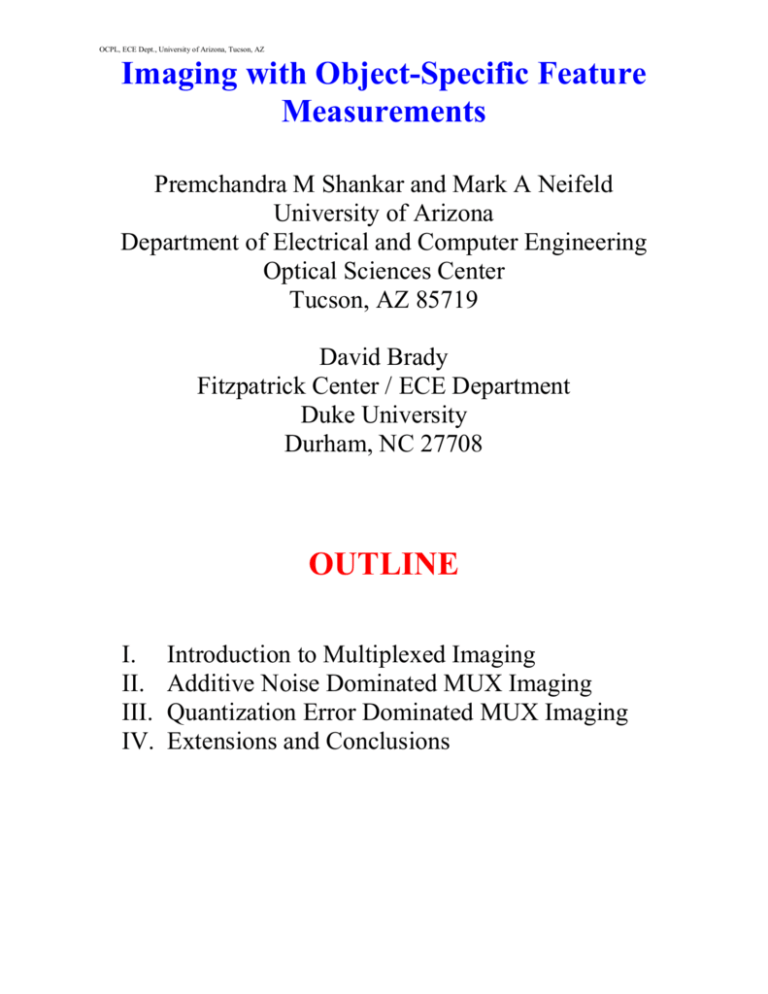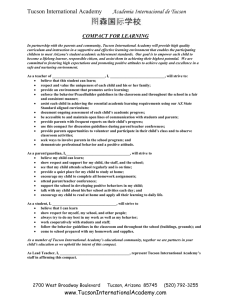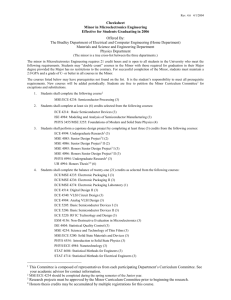Imaging with Object-Specific Feature Measurements
advertisement

OCPL, ECE Dept., University of Arizona, Tucson, AZ Imaging with Object-Specific Feature Measurements Premchandra M Shankar and Mark A Neifeld University of Arizona Department of Electrical and Computer Engineering Optical Sciences Center Tucson, AZ 85719 David Brady Fitzpatrick Center / ECE Department Duke University Durham, NC 27708 OUTLINE I. II. III. IV. Introduction to Multiplexed Imaging Additive Noise Dominated MUX Imaging Quantization Error Dominated MUX Imaging Extensions and Conclusions OCPL, ECE Dept., University of Arizona, Tucson, AZ Feature Extraction and Imaging Many tasks require feature extraction - Object recognition - Image enhancement - Data compression Features are usually computed from image measurement Feature Extraction Conventional imager fS Direct Image Object Linear features may be measured directly MUX imager Object Implementation Options - Diffractive optical elements - Micromirror arrays - Volume holographic techniques fM OCPL, ECE Dept., University of Arizona, Tucson, AZ MUX Imaging Framework Spatially discrete object vector g (Nx1) Feature projection matrix P (MxN) Linear features vector f = Pg (Mx1) Local features: g1 f1 g2 f2 g3 f3 Input Object Sequence of object blocks Dual-Rail Optical Measurement: f = f+ - f where f+ = P+ g and P+ f - = P- g f+ f g Object P- f- OCPL, ECE Dept., University of Arizona, Tucson, AZ Principal Component Features PCA provides minimum MSE for image reconstruction Examine PCA features for noise-free imaging - 112x92 pixels in original object - N = 4x4 object blocks for MUX imaging - Retain M = 5 features per block for MSE = 2.5 DIRECT 5 PCA features Demonstrates reduction from 10,304 detectors to 3,220 We have ignored measurement noise. OCPL, ECE Dept., University of Arizona, Tucson, AZ The Photon Count Constraint Photons I Object N - Detector Array Direct Image Photons P Object M - MUX Detector Array MUX features SNR is determined by number of object photons A fair comparison requires equal number of photons Feature measurement must share photon budget Maximum column sum of projection matrix P = 1 OCPL, ECE Dept., University of Arizona, Tucson, AZ The Photon Count Constraint Consider additive white Gaussian noise Normalized feature projectors ∑ p2ij = 1 , 1<i<M j Direct measurement x=g+n fs = p·x MSESTD = <(fT-fs)2> where fT = p·g MSESTD = σ2 MUX measurement y = (1/C) p·g + n where C = max ∑pij = maximum column sum j i fM = Cy MSEMUX = <(fT-fM)2> MSEMUX = C2 σ2 C increases with number of features More features produce lower fidelity per feature OCPL, ECE Dept., University of Arizona, Tucson, AZ AWGN Dominated Imaging Examine feature measurement fidelity - MSEMUX < MSESTD for M<7 Tradeoff between reconstruction MSE & M Two sources of error in reconstruction - error from throwing away features - additive noise from measurement OCPL, ECE Dept., University of Arizona, Tucson, AZ AWGN Dominated Imaging Minimum MSE vs noise MSEMUX < MSEDIRECT for σ2 > 100 Sample reconstruction Direct 112x92 MUX MSE = 100 MSE = 100 M = 10, N = 8x8 Direct MSE = 900 MUX MSE = 160, M=6 OCPL, ECE Dept., University of Arizona, Tucson, AZ Quantization Error Limited Case Setup Original image True Features S-bit Quantizer K-bit Quantizer DIRECT image MUX features STD Features MUX reconstructed image Photon count constraint is no longer relevant Consider the case when S = 4 and K = 8 Local features from N=8x8 object blocks Feature fidelity - MUX features are better than STD. OCPL, ECE Dept., University of Arizona, Tucson, AZ Quantization Error Limited Case Reconstruction 32 features x 8 bits per feature = 256 bits MUX 8x8 pixels x 4 bits per pixel = 256 bits DIRECT Demonstrates - Reduction in MSE from 18 to 15 - Reduction of 10,304 detectors to 5,152 Example reconstruction Direct, MSE = 18 MUX, MSE = 15 OCPL, ECE Dept., University of Arizona, Tucson, AZ Extensions Global Image Features Trained on large number of 32x32 images. MSEMUX < MSESTD for 25 or less features Example reconstruction Direct MSE=1000 MUX MSE=576 - Reduction from 1,024 detectors to 51 - Reduction in MSE from 1000 to 576 OCPL, ECE Dept., University of Arizona, Tucson, AZ Extensions ICA features Features optimized in information theoretical sense Assumption of Gaussian object is not required Minimize mutual information among features Local features from N=8x8 object blocks - AWGN variance of 100 ICA feature measurements superior in the same way OCPL, ECE Dept., University of Arizona, Tucson, AZ Extensions Water filling Some features are more important than others Photons distributed according to feature importance Optimization Gradient search to find features optimized both in mean square error and photon count constraint. Minimal improvement in feature MSE. OCPL, ECE Dept., University of Arizona, Tucson, AZ Conclusions Reduction in number of detectors Reduces noise when measurements are dominated by - AWGN: for σ2 > σ2min - Quantization Error Valid for both local and global features Alternate features (e.g., ICA) can be measured similarly Continuing work on optimization






